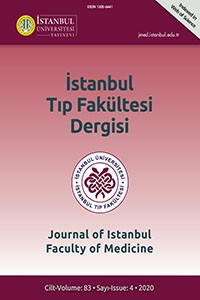DISSEMINE INTRAVASCULAR COAGULATION MAY BE THE PRESENTING FEATURE FOR CHRONIC MYELOMONOCYTIC LEUKEMIA
Öz
Chronic myelomonocytic leukemia (CMML) is a malignant myeloid stem cell disease accompanied by dysplasia in the context of myeloproliferative disease. Peripheral cytopenias (mainly anemia and thrombocytopenia) and hepatosplenomegaly are common findings. Dramatic leukocytosis can also be seen without transformation to acute myeloid leukemia (AML). In some cases, this is associated with leukostasis and end organ damage. Splenomegaly is present in up to 25% of patients and is often accompanied by hepatomegaly, lymphadenopathy, or nodular cutaneous leukemic infiltrates. The acquired cogulation defect may be due to factor X binding to atypical monocytes, resulting in acquired factor X deficiency. We would like to highlight the challenging diagnosis and treatment of CMML.
Kaynakça
- 1. Bernat AL, Priola SM, Elsawy A, et al. Chronic subdural collection overlying an intra-axial hemorrhagic lesion in chronic myelomonocytic leukemia: special report and review of the literature. Expert Rev Neurother 2018;18(5):371-7.
- 2. Arber DA, Orazi A, Hasserjian R, et al. The 2016 revision to the World Health Organization classification of myeloid neoplasms and acute leukemia. Blood 2016;127(20):2391- 405.
- 3. Altieri DC, Edgington TS. The saturable high affinity association of factor X to ADP-stimulated monocytes defines a novel function of the Mac-1 receptor. J Biol Chem 1988;263(15):7007-15.
- 4. Edwards RL, Rickles FR, Bobrove AM. Mononuclear cell tissue factor: cell of origin and requirements for activation. Blood 1979;54(2):359-70. [CrossRef]
- 5. Gregory SA, Kornbluth RS, Helin H, et al. Monocyte procoagulant inducing factor: a lymphokine involved in the T cell-instructed monocyte procoagulant response to antigen. J Immunol 1986;137(10):3231-9.
- 6. Edwards RL, Rickles FR, Cronlund M. Abnormalities of blood coagulation in patients with cancer. Mononuclear cell tissue factor generation. J Lab Clin Med 1981;98(6):917-28.
- 7. Kantarjian H, Issa JP, Rosenfeld CS, et al. Decitabine improves patient outcomes in myelodysplastic syndromes: results of a phase III randomized study. Cancer 2006;106(8):1794-803.
- 8. Kantarjian H, Oki Y, Garcia-Manero G, et al. Results of a randomized study of 3 schedules of low-dose decitabine in higher-risk myelodysplastic syndrome and chronic myelomonocytic leukemia. Blood 2007;109(1):52-7.
- 9. Kantarjian HM, O’Brien S, Shan J, et al. Update of the decitabine experience in higher risk myelodysplastic syndrome and analysis of prognostic factors associated with outcome. Cancer 2007;109(2):265-73.
- 10. Santini V, Allione B, Zini G, et al. A phase II, multicentre trial of decitabine in higher-risk chronic myelomonocytic leukemia. Leukemia 2018;32(2):413-8. [
Öz
Kaynakça
- 1. Bernat AL, Priola SM, Elsawy A, et al. Chronic subdural collection overlying an intra-axial hemorrhagic lesion in chronic myelomonocytic leukemia: special report and review of the literature. Expert Rev Neurother 2018;18(5):371-7.
- 2. Arber DA, Orazi A, Hasserjian R, et al. The 2016 revision to the World Health Organization classification of myeloid neoplasms and acute leukemia. Blood 2016;127(20):2391- 405.
- 3. Altieri DC, Edgington TS. The saturable high affinity association of factor X to ADP-stimulated monocytes defines a novel function of the Mac-1 receptor. J Biol Chem 1988;263(15):7007-15.
- 4. Edwards RL, Rickles FR, Bobrove AM. Mononuclear cell tissue factor: cell of origin and requirements for activation. Blood 1979;54(2):359-70. [CrossRef]
- 5. Gregory SA, Kornbluth RS, Helin H, et al. Monocyte procoagulant inducing factor: a lymphokine involved in the T cell-instructed monocyte procoagulant response to antigen. J Immunol 1986;137(10):3231-9.
- 6. Edwards RL, Rickles FR, Cronlund M. Abnormalities of blood coagulation in patients with cancer. Mononuclear cell tissue factor generation. J Lab Clin Med 1981;98(6):917-28.
- 7. Kantarjian H, Issa JP, Rosenfeld CS, et al. Decitabine improves patient outcomes in myelodysplastic syndromes: results of a phase III randomized study. Cancer 2006;106(8):1794-803.
- 8. Kantarjian H, Oki Y, Garcia-Manero G, et al. Results of a randomized study of 3 schedules of low-dose decitabine in higher-risk myelodysplastic syndrome and chronic myelomonocytic leukemia. Blood 2007;109(1):52-7.
- 9. Kantarjian HM, O’Brien S, Shan J, et al. Update of the decitabine experience in higher risk myelodysplastic syndrome and analysis of prognostic factors associated with outcome. Cancer 2007;109(2):265-73.
- 10. Santini V, Allione B, Zini G, et al. A phase II, multicentre trial of decitabine in higher-risk chronic myelomonocytic leukemia. Leukemia 2018;32(2):413-8. [
Ayrıntılar
| Birincil Dil | İngilizce |
|---|---|
| Konular | Sağlık Kurumları Yönetimi |
| Bölüm | Editöre Mektup |
| Yazarlar | |
| Yayımlanma Tarihi | 19 Ekim 2020 |
| Gönderilme Tarihi | 24 Temmuz 2019 |
| Yayımlandığı Sayı | Yıl 2020 Cilt: 83 Sayı: 4 |
Kaynak Göster
Contact information and address
Addressi: İ.Ü. İstanbul Tıp Fakültesi Dekanlığı, Turgut Özal Cad. 34093 Çapa, Fatih, İstanbul, TÜRKİYE
Email: itfdergisi@istanbul.edu.tr
Phone: +90 212 414 21 61


